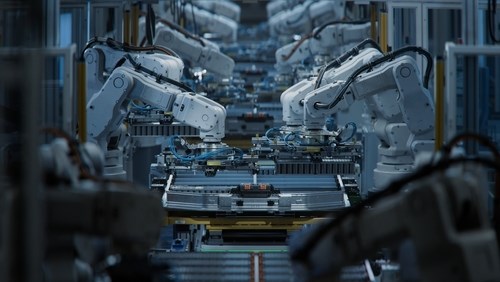
SCANOLOGY has just introduced NimbleTrack Gen2. With upgraded technology, SCANOLOGY's NimbleTrack Gen2 is capable of scanning large and complex areas significantly faster, while maintaining measurement-level accuracy. This is the next generation of the company's mobile optical tracking and 3D scanning systems. SCANOLOGY's NimbleTrack Gen2 is designed to deliver higher performance, especially in speed and measurement range.

A breakthrough opportunity for R&D processes awaits the Vietnamese engineering community. The specialized workshop "Driving Engineering Innovation Through Smart Simulation" organized by ANSYS will take place on October 29, 2025, at the Innovation Hub Building, updating the latest advanced simulation solutions for the manufacturing, electronics design, and Nano-Micro industries.

In the global race to automate manufacturing, China is emerging as a pioneer with the “dark factory” model – where robots and artificial intelligence completely replace humans. Requiring no light or rest, the new generation of factories operate continuously 24/7 with superior precision and efficiency.
In the global race to automate manufacturing, China is emerging as a pioneer with the “dark factory” model – where robots and artificial intelligence completely replace humans. Requiring no light or rest, the new generation of factories operate continuously 24/7 with superior precision and efficiency.
The concept of “Dark Factory” or “Lights-out Factory” refers to factories that are operated entirely by automatic systems, without the constant presence of humans. The outstanding features of this model are that there is no need for lighting, no need for air conditioning, no canteen, no shifts – and no permanent workers. All production activities are performed by industrial robots, artificial intelligence (AI) and advanced production management software (MOM – Manufacturing Operations Management).
![]()
The Dark Factory model is considered ideal in modern manufacturing, but it is only feasible when the technological infrastructure is strong enough and capable of replacing humans in both technical and cognitive aspects. With the remarkable development of AI, IoT, visual sensors and machine learning systems, China is currently the pioneering country to bring this model into reality.
One of the most typical examples of the Dark Factory model is Xiaomi's super factory - first announced in 2023. This production complex is up to 81,000 m² (equivalent to 11 football fields), operates fully automatically, does not require lighting, has no on-site personnel and operates continuously 24/7. The factory is integrated with the HyperIMP super-intelligent manufacturing platform, capable of monitoring, analyzing real-time data and self-adjusting operations without human intervention.
By mid-2024, Xiaomi will continue to introduce another factory with a scale of up to 720,000 m² in the Beijing Economic and Technological Development Zone, specializing in the production of electric vehicles with a level of automation reaching 91%. The factory is operated by more than 700 robots, continuously performing stages from casting, welding, assembling to quality inspection, with high precision and without interruption.
The key to making the dark factory different is the tight integration of AI – automation – data – monitoring and control systems. In these factories, systems like Xiaomi’s HyperIMP not only control assembly robots, but also have the ability to “teach” robots to adapt, diagnose problems, automatically correct errors and optimize processes in real time.
Visual sensors, infrared recognition, Lidar and computer vision technologies act as “senses” for machines in dark environments, helping them perceive space, determine location and perform tasks as accurately as humans. In addition, MOM software plays a role in coordinating the operations of the entire factory – from production planning, material management to incident warnings and quality assurance.

Benefits of Dark Factory – Increase Performance, Reduce Costs, Optimize Energy
The benefits of the dark factory model are clear. First, operating costs are drastically reduced by eliminating the need for human-service utilities such as lighting, heating, air conditioning, toilets, catering areas, etc. According to the International Energy Agency (IEA), energy consumption in factories can be reduced by 15%–20% by eliminating human support systems.
Second, productivity and product quality are improved. Robots work non-stop, without strikes, no demands for salary increases or reduced working hours. AI can detect errors with an accuracy far beyond human capabilities, while maintaining high performance consistently and continuously.
Finally, Dark Factory also supports countries like China in realizing their commitment to carbon neutrality by 2060 by reducing waste and increasing resource efficiency in production.
China’s current success with the Dark Factory model is no coincidence. Since 2015, the government has implemented the “Made in China 2025” initiative, prioritizing the development of robots, AI, and smart factories. By 2022, China will have installed more than 290,000 industrial robots, accounting for 52% of the global total – far exceeding the US and Japan combined.
China’s robot density index (the number of robots per 10,000 workers) has also increased sharply, from 49 (in 2012) to 470 in 2024, ranking third globally after South Korea and Singapore. This is the result of a systematic strategy in building hardware capabilities (robots, sensors, smart manufacturing equipment) and software (AI machine learning, production management software, IoT, etc.).
Besides Xiaomi, many other large Chinese enterprises are also realizing the shadow factory model:
These achievements show that the Dark Factory model is no longer theoretical, but has become a reality with clear efficiency in terms of cost and productivity.
In addition to economic benefits, the Dark Factory model poses huge social challenges. According to data from the Foreign Affairs Forum, China's manufacturing industry currently employs more than 100 million people. Replacing workers with robots, without an effective transformation strategy, could lead to a wave of mass unemployment and social unrest.
In 2023, a strike broke out in Guangdong due to the reason that jobs were being replaced by robots. This reflects the concerns of workers and shows the imbalance between the speed of technological development and the shift in the workforce.
Retraining human resources is urgent, requiring investment in new vocational education, especially in areas such as AI, data science, robot operation and maintenance. In addition, technical challenges such as cybersecurity risks, system failures, and AI reliability are still factors that need to be closely monitored.
The shadow factory model is an inevitable trend of the global industry, especially in the fields of mass production and high-precision manufacturing. China, with its long-term vision and synchronous implementation capacity, is playing a pioneering role in this revolution.
However, balancing automation - productivity - sustainable social development will be an important strategic problem not only for China, but for all industrialized countries in the future. Success comes not only from technology, but also from the ability to manage the transition, maintain jobs and ensure social stability in a new era of production.
In the context of automation and artificial intelligence gradually replacing the role of humans in production lines, the trend of switching to "unmanned factories" is no longer an option, but has become a vital strategy to improve competitiveness and optimize resources. Realizing that, V-Proud is proud to be one of the pioneering enterprises in Vietnam to welcome the wave of smart manufacturing - gradually investing in automated measurement solutions, digital data management and 3D scanning equipment to support domestic enterprises to upgrade their production processes.
Not only importing and distributing high-tech industrial equipment from Europe, V-Proud also builds a 3D Scan Center and an ecosystem to support digital transformation of production - aiming to become a strategic partner for factories and industrial parks in the modernization journey. In an era where productivity and precision are core factors, timely investment in smart manufacturing infrastructure is a long-term advantage. And V-Proud - as a bridge between technology and businesses - is holding the key to the future of manufacturing in Vietnam.
(84) 896 555 247